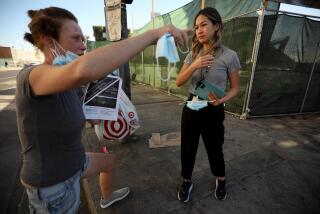MEDICINE HIV INFECTION : ‘Second Wave’ of AIDS Epidemic Threatens Women
- Share via
BOSTON — Women who are in heterosexual relationships but do not know that their partners are bisexual or use drugs are among the most rapidly growing groups at risk for developing AIDS, a San Francisco researcher said Monday.
The “second wave” of the epidemic will claim women who never believed they were at risk for human immunodeficiency virus (HIV) infection, said Judith Cohen, a UC San Francisco professor of epidemiology. Cohen is director of the Assn. for Women’s AIDS Research and Education, a group formed six years ago to understand and prevent HIV infection among women.
She says the trend dictates that any woman entering a new relationship should make use of condoms.
About 10,000 women have been found to have AIDS and more than 100,000 women are infected with HIV, the U.S. Centers for Disease Control has reported. By 1991, AIDS is expected to become the fifth leading cause of death for U.S. women of child-bearing age. Women with HIV are the major source of infection for infants with AIDS.
Until recently, Cohen said, women were at risk because they were intravenous drug users or had multiple sex partners. But the risk profile has widened to include women who are naive about their chances of contracting HIV, Cohen said.
“Conventional wisdom leads people to believe that heterosexual women who don’t use IV drugs or sleep around are not at risk for developing AIDS. This is not true,” Cohen said at the annual meeting of the American Psychological Assn. The meeting concludes today.
According to Cohen, studies in Western states show that about one-third of HIV infection among women occurs through heterosexual contact and one-third through women’s IV drug use. Another one-third of women have no idea how they contracted the virus.
The emphasis in the early 1980s on AIDS as a disease of homosexual men and IV drug users has led many women to dismiss their risk, said Margaret Chesney, an epidemiologist at UC San Francisco.
“Large groups--like women--thought, ‘This doesn’t involve me.’ Now we’re saying that it’s time to begin worrying,” Chesney said.
Some women might know their partners have other sexual contacts or use IV drugs, placing them at risk for contracting the virus. But poor women without social support often feel forced to stay in high-risk relationships because they have have nowhere else to go, Cohen said.
“We’ve seen women who know their partners use drugs. (The women) know they are at risk. But they don’t have many choices,” she said.
But the HIV infection rate is also increasing among middle-class women who are unaware of any risk factors in their lives, she said.
In Cohen’s sample of women in the Bay Area who seek an HIV test, “40% of women who found out they were HIV-positive did not know they were at risk until just before they called us.”





